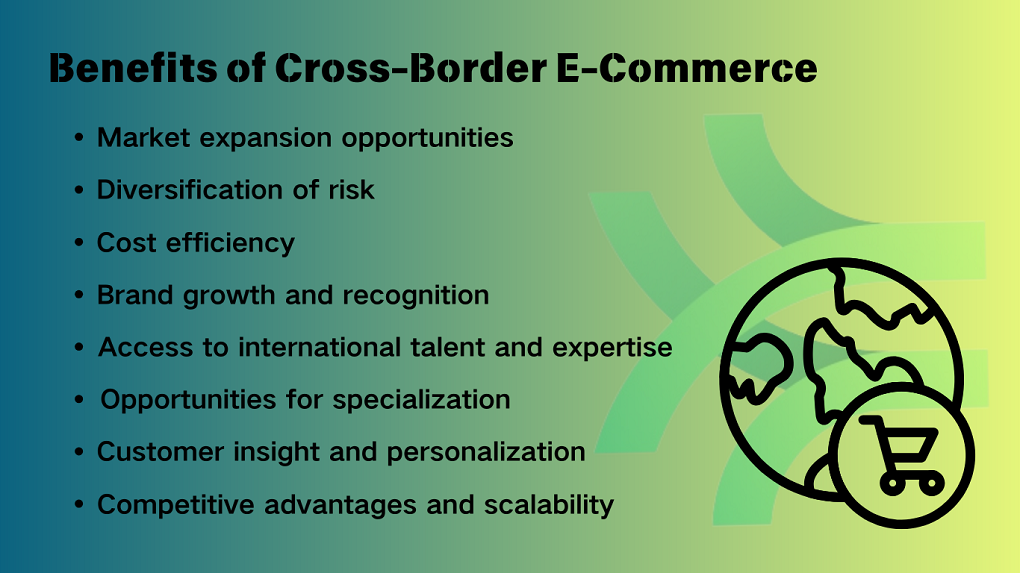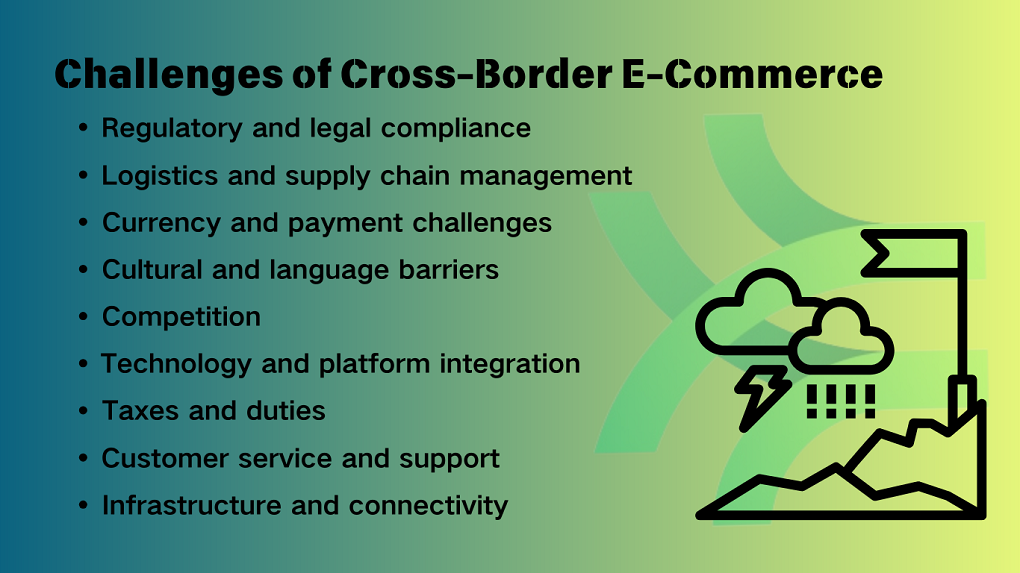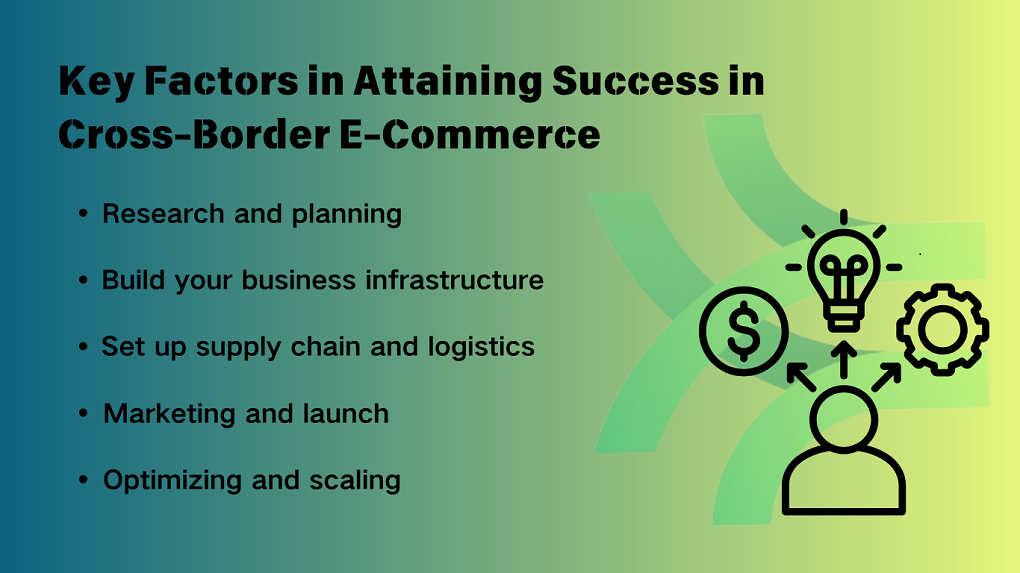Cross-border e-commerce, which is one of the online-shopping mode, has experienced rapid growth over the past decade, driven by globalization, digital transformation, and increasing consumer demand for diverse products. Global cross-border e-commerce is projected to reach USD 2.25 trillion by 2026, reflecting a compound annual growth rate (CAGR) of 17%. Although the high volatility of the cross-border e-commerce market, quite a few businesses are still eager to enter. Before that, businesses need to know what it is.
Cross-border e-commerce: General introduction
key words:Cross-border e-commerce, Global market, Cost efficiency, Scalability, Supply chain, Logistics, Order fulfillment, Customer satisfaction, Brand growth, Localization

In this article
- What is cross-border e-commerce?
- Benefits of cross-border e-Commerce
- Challenges of cross-border e-commerce
- Key factors in attaining success in cross-border e-commerce
- Cross-border e-commerce FAQ+
- What does the future hold for cross-border e-commerce?
- How does Shipro help cross-border e-commerce businesses?
- Get ready to revolutionize your e-commerce business fulfillment process, taking your business to a new height?
What is cross-border e-commerce?
Cross-border e-commerce refers to global online trade It involves the purchase and sale of the products across international borders through e-commerce platforms, such as Amazon, Alibaba, Shopify, allowing companies to reach global markets and enabling consumers to access a broader range of products not available locally.
It includes B2B, B2C, C2C and D2C for cross-border e-commerce businesses, taking B2C approach the most prevalent one. A significant increase in global cross-border B2C e-commerce market value is expected to rise from USD 785 billion in 2021 to USD 7938 billion in 2030, in terms of Statista.
Benefits of cross-border e-Commerce
With the rapid development of cross-border e-commerce, governments are tightening e-commerce regulations, focusing on taxation, consumer protection, and data privacy. Despite additional obstacles awaiting new entrants to overcome, numerous entrepreneurs are still scrambling to join this competition. The fundamental reason behind this phenomenon must be the benefits that come with entering the competition.
To be specific, the following explains why cross-border e-commerce is popular for businesses.
Market expansion
Access to a global audience beyond domestic markets, increasing customer base and sales opportunities. That can further lead to higher revenue if tapping into underserved or niche markets.
Diversification of Risk
Reduced reliance on a single market or economy, mitigating risks associated with local economic fluctuations. For example, economic instability, seasonal demand, or changing consumer preferences in one country can negatively impact sales. Operating in multiple markets helps businesses offset losses in one region with gains in another. Therefore, this broader market reach ensures resilience against local competition and enhances overall stability.
Cost Efficiency
Lower operational costs in some regions, including warehousing, labor, and logistics. Moreover, it can eliminate the need for physical stores, reducing overhead costs while entering new markets.
Brand Growth and Recognition
Building a global presence and enhances brand reputation and customer trust through international exposure.
Taking Shein for example, a Chinese fast-fashion brand that has gained massive global recognition through cross-border e-commerce by offering trendy, affordable fashion to over 150 countries. Meanwhile, tailored local website, social media marketing, efficient logistics, and personalized shopping experiences, making it a global leader in cross-border e-commerce.
Access to International Talent and Expertise
Collaborating with local partners or employing international teams can improve operational efficiency. It allows businesses to leverage diverse skills, knowledge, and perspectives that enhance their global operations. That can be the results of providing valuable market insight, streamlining operations, fostering innovation, and ensuring regulatory compliance. This strategic advantage helps businesses succeed in diverse global markets and maintain a competitive edge.
Opportunities for Specialization
Specialization in cross-border e-commerce allows businesses to tap into niche markets, focus on their strengths, and deliver tailored products or services that meet the unique demands of international customers. By targeting specific audiences, businesses can reduce competition, increase profitability, and position themselves as experts in their field. This approach also streamlines operations, ensuring more efficient resource allocation and cost savings. Additionally, specialization helps establish a distinct brand identity, fostering customer loyalty and long-term growth. Overall, cross-border e-commerce creates opportunities for businesses to differentiate themselves in the global marketplace, driving sustainable success.
Customer Insight and Personalization
Businesses can understand and cater better to diverse international markets through this transformative benefit. By leveraging data to deliver tailored experiences, businesses are able to enhance customer satisfaction, build brand loyalty, and gain a competitive edge. The business mode of cross-border e-commerce help businesses acquire the transformative power easier, that will further facilitate business development.
Netflix’s success shows how personalization and localization drive global growth. By tailoring contentArr, pricing, and user experiences to regional preferences, Netflix has built a strong connection with its customers worldwide.
Competitive advantages and scalability
Offering businesses a powerful avenue to achieve competitive advantages through global market access, brand differentiation, and risk diversification, while enabling scalability with cost-efficient, technology-driven solutions. By tapping into international opportunities and leveraging digital infrastructure, businesses can grow rapidly, improve profitability, and solidify their position as global players in an increasingly interconnected economy.

Challenges of cross-border e-commerce
Cross-border e-commerce offers significant opportunities, however, it also comes with a range of challenges that businesses must navigate to succeed. No matter what the reasons are, analyses are necessary.
Regulatory and Legal Compliance
Complex laws and regulations, import/export restrictions, and tariffs and duties across different countries result in challenges faced by cross-border e-commerce businesses. Businesses must navigate diverse taxation systems, customs regulations, data protection standards, and consumer protection laws, which often require significant resources, expertise, and continuous monitoring. The cost of non-compliance, ranging from financial penalties to reputational damage, further underscores the importance of adhering to these regulations. Successfully addressing these challenges requires businesses to invest in legal expertise, robust compliance systems, and adaptive strategies to ensure smooth international operations and sustainable growth in the global marketplace. For example, Amazon’s cross-border operations face obstacles like India’s GST rules, GDPR fines in Europe, and strict product laws, highlighting the need for the robust compliance and localized strategies.
Logistics and Supply Chain Management
International shipping, customs regulations, and return management are the significant problems that businesses need to consider. High costs, longer delivery times, and infrastructure variability further complicate operations, while customer expectations for speed and reliability remain high. Therefore, ensuring smooth operations and maintaining customer satisfaction in global markets requires businesses to possess strategic investment, reliable logistics partnerships and localized solutions.
Currency and Payment Challenges
Stemming from currency fluctuation (exchange rate volatility), varied customer preferences, fraud risks, and complex regulatory requirement. These issues can lead to higher costs, slower transactions and potential customer dissatisfaction. Businesses must invest in secure, flexible payment systems, support multiple currencies and methods, and ensure transparency to build trust and provide a seamless shopping experience in international market.
Cultural and Language Barriers
Businesses must adapt to diverse customer behaviors, communication styles, and preferences across countries. For example, miscommunications or poorly translated product descriptions can deter customers and lead to negative experiences. Overcoming these challenges requires effective translation, localized marketing, culturally sensitive customer service, and an understanding of local norms and expectations.
Competition
Competing with well-established local businesses with deep market knowledge or global giants with extensive resources like Amazon and Alibaba can be challenging. Besides, customers in different regions may be highly price-sensitive, limiting pricing flexibility. As a result, businesses should differentiate themselves through localized products, pricing, and marketing strategies, while also adapting to consumer preferences and regulatory landscapes to succeed in foreign markets.
Technology and Platform Integration
E-commerce platforms may not support all countries equally, requiring additional technology solutions for payments, language, or logistics. Then, operating internationally increases exposure to cyber threats, making robust cybersecurity measures essential.
Taxes and Duties
This part refers to navigating international tax regulations which include VAT, GST, and other sales taxes and unexpected customs duties and tariffs that can lead to abandoned carts and customer dissatisfaction. So the abilities of careful planning, compliance with local laws, and transparent communication with customers about pricing, taxes and potential delays for businesses are important. Businesses that manage these aspects effectively can minimize risk and improve the customer experience in global markets
Customer Service and Support
Real-time customer support across multiple time zones and varying expectations regarding response times, return policies and overall service quality can be challenging. To reduce the impacts, it requires flexible, 24/7 support systems, culturally sensitive communication, and efficient resource allocation to meet global customer needs and ensure satisfaction.
Infrastructure and Connectivity
The challenges of infrastructure and connectivity are reflected in limited access in emerging markets and technology disparities. Some regions may lack the infrastructure for efficient logistics, reliable internet access, or widespread e-commerce adoption. Businesses need to ensure their websites and platforms function smoothly on various devices and connection speeds. To achieve business goals, it is crucial to invest in reliable technology, partner with efficient logistics providers, and adapt their platforms to meet local demands and conditions, assuring smooth operations and customer satisfactions.

Key factors in attaining success in cross-border e-commerce
Once a business is keen for entering the international market, cross-border e-commerce is the way that has to follow or take. It gives brands the chances to open up their visibility on a global scale, however, challenges and opportunities co-exit. Let’s go through the steps of how to start a cross-border e-commerce businesses and become successful.
Research and Planning
This phase is the foundation of a successful cross-border e-commerce business. By analyzing target markets which contains the choice of products and identify the target markets, entrepreneurs can get started on the trip of cross-border businesses. In detail, products determination refers to identification of products with demand in your target markets. Then, conducting focus groups or surveys in the target market to validate product relevance. After that, researching potential or niche markets for chosen products, that focuses on cultural and economic differences. Besides, testing ideas with local users is necessary.
Build Your Business Infrastructure
A solid business infrastructure ensures seamless operations, localized customer experience, and trust in the cross-border e-commerce venture. The first step is to set up the business by registering business and establishing basic infrastructure. By carefully selecting the e-commerce platforms such as Shopify, Temu or Amazon, payment systems, and localization strategies like website translation and pricing to ensure the business operates smoothly and meets the expectations of international customers. This phase emphasizes the importance of usability testing to identify and address potential issues early, creating a frictionless experience for users across different markets.
Set Up Supply Chain and Logistics
After building foundation for scalability, it is essential for delivering a seamless customer experience to establish a reliable supply chain and logistics system. By partnering with trusted shipping providers, optimizing inventory management, and testing delivery processes, businesses ensure timely and cost-effective order fulfillment. Clear communication about shipping times, customs duties, and returns policies builds customer trust and satisfaction. With a well-organized logistics network in place, business is ready to handle international orders efficiently, setting the stage for a smooth launch and sustained growth.
Marketing and Launch
Marketing an launch is related to the tone of business, which starts with branding identity. By creating targeted campaigns, leveraging local platforms or other ads such as Google, and conducting A/B testing, to make sure the brand resonates culturally with international audience. Additionally, a well-executed soft launch with a limited audience allows entrepreneurs to refine a specific approach based on real-world feedback, building momentum for a successful full-scale rollout. With a digital marketing strategy and a user-tested launch, the business is primed to attract customer, establish trust and generate initial sales, paving the way for sustained growth and market expansion.
Optimizing and Scaling
The market planning will be implemented after launching officially, that requires continuous optimization. This is where the business evolves from initial success to long-term growth. In order to stay aligned with market trend and customer needs, the team should monitor performance regularly, gather user feedback, and adjust business strategies effectively. Meanwhile, excellent customer support take up a great proportion of customer satisfaction. The customer support systems include live chat and email should be well tested to make sure prompt and helpful responses. Gradual expansion into new markets and diversification of product offering further solidify the presence in the global market. Your business is will-equipped to thrive in the competitive cross-border e-commerce landscape with a focus on continuous improvement and strategic growth.
A real-world example: Koala
Koala, an Australian furniture brand, successfully expanded internationally by focusing on solving the unique problem of hassle-free, compact, and minimalist furniture for busy customers. With a D2C model, Koala eliminated the need for traditional retail outlet, offering fast, free delivery and a risk-free trial period for their products. The brand made its mark in Japan and South Korea, capitalizing on the region’s growing demand for quality, space-saving home goods and adopting localized marketing strategies to appeal to these markets. By leveraging 3PL, using local warehouses and partnerships with influencers, Koala was able to reduce shipping time , lower costs, and connect with customers more authentically. By leveraging thorough market research, localized offerings, robust logistics, and tailored marketing campaigns, Koala offers localized and seamless experience for international customers, further solidifying their global growth and brand awareness.

Cross-border e-commerce FAQ+
What is cross-border e-commerce?
Cross-border e-commerce refers to the process of selling products or services online to customers in different countries. It involves managing international shipping, compliance with local regulations, currency exchanges, and localized marketing.
Why is cross-border e-commerce important?
It allows businesses to expand their customer base globally, tap into new markets, and increase revenue by reaching international buyers who may not have access to similar products locally.
What products are best suited for cross-border e-commerce?
Products with high demand, low shipping costs, and minimal regulatory restrictions are suitable for cross-border e-commerce business. Such kinds of products are also popular for customers, such as fashion and apparel, electronics and gadgets, beauty and skincare products, and small designed furniture.
How can I choose the right market for cross-border e-commerce?
As mentioned above, conducting market research to evaluate demand for products, market size and purchasing power, competition, cultural fit and local preferences, logistics and operational feasibility.
How can I localize my cross-border e-commerce store?
To localize your cross-border e-commerce store, start by translating your website contentArr into the local languages of your target markets. Ensure that product descriptions, payment instructions, and customer support options are available in those languages to enhance the shopping experience. Display prices in local currencies and offer region-specific payment methods, such as Alipay in China or PayPal in the U.S., to increase convenience for customers. Additionally, adapt the user interface, including date formats, measurement units, and shipping options, to align with local preferences. Finally, incorporate localized marketing strategies, such as promotions during regional holidays or cultural events, to better connect with customers in each market.
How do I build trust with international customers?
To build trust with international customers, provide detailed product descriptions and clear policies on shipping, returns, and warranties. Showcase customer reviews and testimonials to build credibility, and offer multilingual support to cater to diverse audiences. Use secure payment gateways and prominently display trust badges to ensure a safe shopping experience. Additionally, ensure fast, reliable shipping with tracking options to enhance customer confidence and satisfaction.
How can I market my products internationally?
Research local preferences and tailor your contentArr to each market’s language and culture to ensure relevance. Use digital marketing strategies like social media ads, SEO, and influencer partnerships on region-specific platforms. Offer promotions aligned with local holidays or shopping events, such as Black Friday, and engage customers through personalized email marketing and re-targeting ads to re-capture interest. Besides, ensure the website supports local payment methods and provides clear shipping details to build trust and improve the customer experience.
What are the most effective ways to reduce cross-border e-commerce cart abandonment?
Firstly, make sure shipping costs and delivery times are clearly displayed upfront to avoid surprises. Offering multiple trusted payment options, including region-specific methods, to cater to different preferences. Simplify the checkout process by enabling guest checkout and providing auto-fill options for returning customers. At the same time, ensuring your website is secure by displaying trust badges and trust signals prominently, which reassure customers about payment safety. Additionally, provide real-time customer support via live chat or help centers to resolve any last-minute concerns, and send reminder emails or re-targeting ads to encourage customers to complete their purchase.
What does the future hold for cross-border e-commerce?
The future of cross-border e-commerce is exceptionally promising, with significant growth projected in the coming years. The global cross-border e-commerce market is expected to reach $2.2 trillion by 2026, growing at a compound annual growth rate (CAGR) of 27% from 2021 to 2026. Additionally, cross-border transactions are projected to surge from $2.8 trillion in 2023 to $13.57 trillion by 2032, driven by the increasing integration of mobile shopping into the e-commerce industry.
This growth is fueled by technological advancements, changing consumer behavior, and the expansion of internet access worldwide. Notably, in 2023, cross-border e-commerce experienced an annual increase of 44%, outpacing domestic e-commerce growth. Furthermore, cross-border e-commerce is projected to grow at a 26.4% CAGR from 2023 to 2028, indicating a faster rate than global e-commerce as a whole.
Emerging markets are playing a significant role in this expansion. For instance, in the first quarter of 2024, China's cross-border e-commerce trade reached 577.6 billion yuan ($79.76 billion), marking a 9.6% year-on-year increase, with exports growing by 14%. Similarly, regions like Latin America are experiencing substantial growth, with local marketplaces embracing cross-border e-commerce and contributing to the industry's expansion.
As businesses and consumers continue to embrace digital commerce, the cross-border e-commerce sector is poised for sustained growth, offering significant opportunities for global trade and economic development.
No matter for existing cross-border e-commerce businesses or new entrants, it is crucial to develop their own strengths in such highly competitive industry. Shipro’s global logistics systems make cross-border e-commerce better off, getting competitive advantages through cost reduction, logistics management and customer satisfaction etc.
How does Shipro help cross-border e-commerce businesses?
Shipro utilizes own expertise to provide exceptional 3PL services designed to drive and accelerate your e-commerce business growth. We offer comprehensive solutions that involves order fulfillment, inventory management, returns management and last mail delivery based on our rich experience in the fields of e-commerce and logistics.
Learn more about how can Shipro play an indispensable role on the way for the success of your business:
1.Order fulfillment eases the ordering process
Getting rid of the complexity of managing different e-Commerce platforms, our order fulfillment system integrates multiple mainstream platforms such as Shopify and Woocommerce, specializing in modern e-commerce. In this way, you can handle all your orders from different platforms and stores efficiently using a single, unified dashboard, as Shipro streamlines all your marketplaces, order processing automatically from order placement to final delivery. Besides, ordering tracking and reporting tools are available, that contribute to decision-making and transparency-maintaining throughout the whole fulfillment process.
Shipro shows great competence in shipment, drawing from partnerships with localized leading carrier and fulfillment centers that ensure fast shipping speed and best shipping rates, and valuable and extensive experience for coping with customers clearance. Additionally, custom packaging choices offered by Shipro give you the flexibility to shape brand image and enhance your customer experience and impression.
With Shipro as your logistics partner, the improved process efficiency, cost effectiveness, customer satisfaction and unique brand image, these competitive advantages will serve as the foundation and driving force for the scalability of your business.
2.Advanced inventory management system increases the inventory sensitivity
Better inventory control reduces waste cost, that represents higher profits or price advantage. Shipro’s inventory management solutions aim to optimize the inventory, not only for controlling, with real-time tracking, forecasting capabilities for demand, low-stock alerts, and an intuitive interface. Its application is also designed for every businesses, by tailoring your reporting to your specific requirement. Therefore, you can have complete peace of mind about managing inventory.
3.Turn returns into your business success
Returns are troublesome but inevitable in any business, they are even strongly related to the development of businesses. Shipro simplifies the process of returns from initial request to final resolution, leveraging returns as opportunities for growth and customer satisfaction, that help businesses improve brand reputation and customer loyalty. For your customers, quick and hassle-free solutions for returns plays a significant role in their shopping experience; for businesses, returns-handling efficiency and real-time reporting improve operations effectively. Undeniably, all of them can be achieved within tailored and automated returns systems from Shipro.
4.Excellent last mail delivery system lead to increased customer satisfaction and solid band royalty
The last mile is typically the most complex and expensive stage of the supply chain, and it is where customer satisfaction is ultimately determined. As mentioned above, Shipro’s last mile delivery system is designed to guarantee the speed and efficiency, as well as the best shipping rate. The optimal carrier will be automatically selected through our partnerships with over 100 carriers worldwide for each order based on your business rules or specific needs. At the same time, real-time tracking updates are available also for your customers.
5.Scalability, customization, and expert support will keep up with your growth
Shipro evolves alongside with you. Our adaptable and scalable solutions are designed to meet your needs, whether you are a startup managing a handful of orders daily or a well-established brand shipping thousands of orders each months. Once you are with us, the support team with experienced experts is readily available anytime to address any inquires or challenges you may encounter throughout the service. That enable you to depend on our expertise and customized assistance to ensure the efficient management of your logistics. One of the most important reasons for a cross-border e-commerce business to become successful is to keep its uniqueness and irreplaceability, which can be partly brought out by Shipro’s customization of all the solutions at every stage and the needs of different customers.

Get ready to revolutionize your e-commerce business fulfillment process, taking your business to a new height?
Shipro goes beyond being a fulfillment provider, serving as your trusted-strategic partner in achieving cross-border e-commerce businesses success. Our omnichannel fulfillment solutions with centralized order processing, real-time inventory visibility, flexible shipping solutions and tailored packaging position us as the ideal logistics partner for various industries, such as health & beauty, apparel & accessories, consumer electronics and pet supplies, aiming to enhance operational efficiency and achieve sustainable business growth.
With Shipro’s seamless integration into your sales channels, allowing you to focus on growth while we handle the logistics in speciality. Fell free to talk to us and start scaling your e-commerce businesses today!










